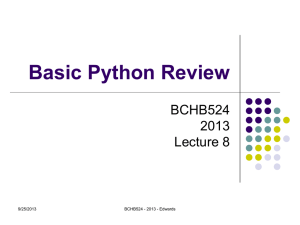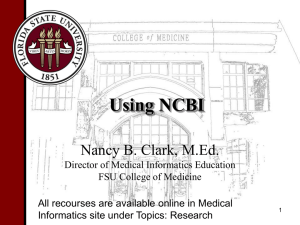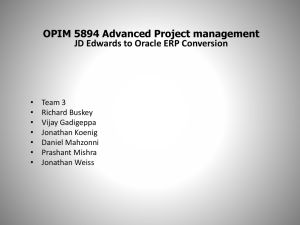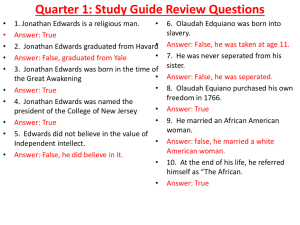Slides - Edwards Lab
advertisement
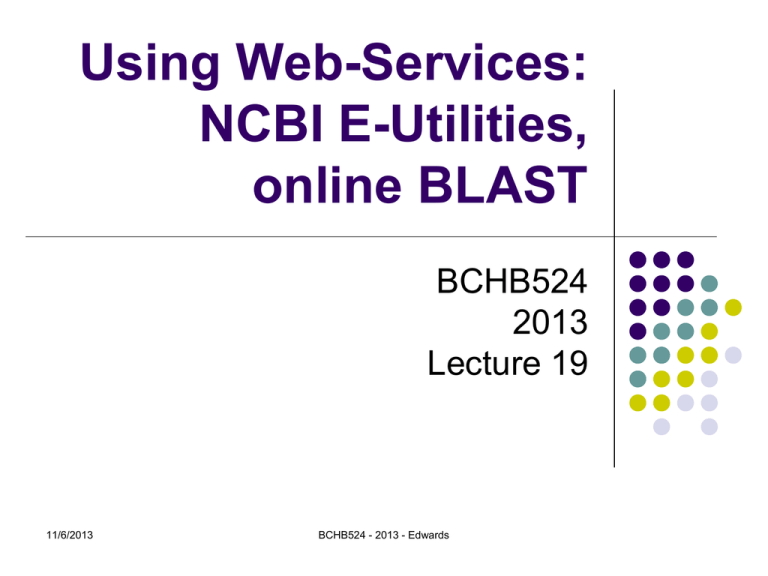
Using Web-Services: NCBI E-Utilities, online BLAST BCHB524 2013 Lecture 19 11/6/2013 BCHB524 - 2013 - Edwards Outline NCBI E-Utilities NCBI Blast …from a script, via the internet …from a script, via the internet Exercises 11/6/2013 BCHB524 - 2013 - Edwards 2 NCBI Entrez Powerful webportal for NCBI's online databases 11/6/2013 Nucleotide Protein PubMed Gene Structure Taxonomy OMIM etc… BCHB524 - 2013 - Edwards 3 NCBI Entrez We can do a lot using a web-browser Look up a specific record nucleotide, protein, mRNA, EST, PubMed, structure,… Search for matches to a gene or disease name Download sequence and other data associated with a nucleotide or protein Sometimes we need to automate the process 11/6/2013 Use Entrez to select and return the items of interest, rather than download, parse, and select. BCHB524 - 2013 - Edwards 4 NCBI E-Utilities Used to automate the use of Entrez capabilities. Google: Entrez Programming Utilities http://www.ncbi.nlm.nih.gov/books/NBK25501/ See also, Chapter 8 of the BioPython tutorial Play nice with the Entrez resources! 11/6/2013 At most 100 requests during the day Supply your email address Use history for large requests …otherwise you or your computer could be banned! BioPython automates many of the requirements... BCHB524 - 2013 - Edwards 5 NCBI E-Utilities No need to use Python, BioPython Can form urls and parse XML directly. E-Info PubMed Info 11/6/2013 BCHB524 - 2013 - Edwards 6 BioPython and Entrez E-Utilities As you might expect BioPython provides some nice tools to simplify this process from Bio import Entrez Entrez.email = 'netid@georgetown.edu' handle = Entrez.einfo() result = Entrez.read(handle) print result["DbList"] handle = Entrez.einfo(db='pubmed') result = Entrez.read(handle,validate=False) print result["DbInfo"]["Description"] print result["DbInfo"]["Count"] print result["DbInfo"].keys() 11/6/2013 BCHB524 - 2013 - Edwards 7 BioPython and Entrez EUtililities "Thin" wrapper around E-Utilities webservices Use E-Utilities argument names Use Entrez.read to make a simple dictionary from the XML results. db for database name, for example Could also parse XML directly (ElementTree), or get results in genbank format (for sequence) Use result.keys() to "discover" structure of returned results. 11/6/2013 BCHB524 - 2013 - Edwards 8 E-Utilities Web-Services E-Info E-Search Search within a particular database Returns "primary ids" E-Fetch Discover database names and fields Download database entries by primary ids Others: 11/6/2013 E-Link, E-Post, E-Summary, E-GQuery BCHB524 - 2013 - Edwards 9 Using ESearch By default only get back some of the ids: Use retmax to get back more… Meaning of returned id is database specific… from Bio import Entrez Entrez.email = 'netid@georgetown.edu' handle = Entrez.esearch(db="pubmed", term="BRCA1") result = Entrez.read(handle) print result["Count"] print result["IdList"] handle = Entrez.esearch(db="nucleotide", term="Cypripedioideae[Orgn] AND matK[Gene]") result = Entrez.read(handle) print result["Count"] print result["IdList"] 11/6/2013 BCHB524 - 2013 - Edwards 10 Using EFetch from Bio import Entrez, SeqIO Entrez.email = 'netid@georgetown.edu' handle = Entrez.efetch(db="nucleotide", id="186972394", rettype="gb") print handle.read() handle = Entrez.esearch(db="nucleotide", term="Cypripedioideae[Orgn] AND matK[Gene]") result = Entrez.read(handle) idlist = ','.join(result["IdList"]) handle = Entrez.efetch(db="nucleotide", id=idlist, rettype="gb") for r in SeqIO.parse(handle, "genbank"): print r.id, r.description 11/6/2013 BCHB524 - 2013 - Edwards 11 ESearch and EFetch together Entrez provides a more efficient way to combine ESearch and EFetch After esearch, Entrez already knows the ids you want! Sending the ids back with efetch makes Entrez work much harder Use the history mechanism to "remind" Entrez that it already knows the ids Access large result sets in "chunks". 11/6/2013 BCHB524 - 2013 - Edwards 12 ESearch and EFetch using esearch history from Bio import Entrez, SeqIO Entrez.email = 'netid@georgetown.edu' handle = Entrez.esearch(db="nucleotide", term="Cypripedioideae[Orgn]", usehistory="y") result = Entrez.read(handle) handle.close() count = int(result["Count"]) session_cookie = result["WebEnv"] query_key = result["QueryKey"] print count, session_cookie, query_key # Get the results in chunks of 100 chunk_size = 100 for chunk_start in range(0,count,chunk_size) : handle = Entrez.efetch(db="nucleotide", rettype="gb", retstart=chunk_start, retmax=chunk_size, webenv=session_cookie, query_key=query_key) for r in SeqIO.parse(handle,"genbank"): print r.id, r.description 11/6/2013 handle.close() BCHB524 - 2013 - Edwards 13 NCBI Blast NCBI provides a very powerful blast search service on the web We can access this infrastructure as a web-service BioPython makes this easy! 11/6/2013 Ch. 7.1 in Tutorial BCHB524 - 2013 - Edwards 14 NCBI Blast Help on function qblast in module Bio.Blast.NCBIWWW: Lots of parameters… Essentially mirrors blast options You need to know how to use blast first! 11/6/2013 qblast(program, database, sequence, ...) Do a BLAST search using the QBLAST server at NCBI. Supports all parameters of the qblast API for Put and Get. Some useful parameters: program blastn, blastp, blastx, tblastn, or tblastx (lower case) database Which database to search against (e.g. "nr"). sequence The sequence to search. ncbi_gi TRUE/FALSE whether to give 'gi' identifier. descriptions Number of descriptions to show. Def 500. alignments Number of alignments to show. Def 500. expect An expect value cutoff. Def 10.0. matrix_name Specify an alt. matrix (PAM30, PAM70, BLOSUM80, BLOSUM45). filter "none" turns off filtering. Default no filtering format_type "HTML", "Text", "ASN.1", or "XML". Def. "XML". entrez_query Entrez query to limit Blast search hitlist_size Number of hits to return. Default 50 megablast TRUE/FALSE whether to use MEga BLAST algorithm (blastn only) service plain, psi, phi, rpsblast, megablast (lower case) This function does no checking of the validity of the parameters and passes the values to the server as is. More help is available at: http://www.ncbi.nlm.nih.gov/BLAST/blast_overview.html BCHB524 - 2013 - Edwards 15 NCBI Blast Required parameters: Blast program, Blast database, Sequence Returns XML format results, by default. Save results to a file, for parsing… import os.path from Bio.Blast import NCBIWWW if not os.path.exists("blastn-nr-8332116.xml"): result_handle = NCBIWWW.qblast("blastn", "nr", "8332116") blast_results = result_handle.read() result_handle.close() save_file = open("blastn-nr-8332116.xml", "w") save_file.write(blast_results) save_file.close() # Do something with the blast results in blastn-nr-8332116.xml 11/6/2013 BCHB524 - 2013 - Edwards 16 NCBI Blast Parsing Results need to be parsed in order to be useful… from Bio.Blast import NCBIXML result_handle = open("blastn-nr-8332116.xml") for blast_result in NCBIXML.parse(result_handle): for desc in blast_result.descriptions: if desc.e < 1e-5: print '****Alignment****' print 'sequence:', desc.title print 'e value:', desc.e 11/6/2013 BCHB524 - 2013 - Edwards 17 Exercises Putative Human – Mouse BRCA1 Orthologs Write a program using NCBI's E-Utilities to retrieve the ids of RefSeq human BRCA1 proteins from NCBI. Use the query: "Homo sapiens"[Organism] AND BRCA1[Gene Name] AND REFSEQ Extend your program to search these protein ids (one at a time) vs RefSeq proteins (refseq_protein) using the NCBI blast web-service. Further extend your program to filter the results for significance (E-value < 1.0e-5) and to extract mouse sequences (match "Mus musculus" in the description). 11/6/2013 BCHB524 - 2013 - Edwards 18


